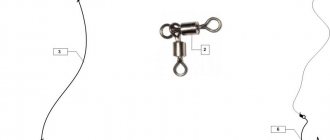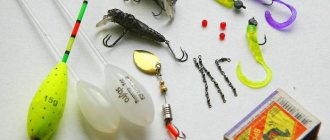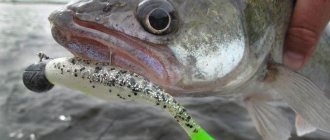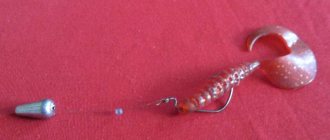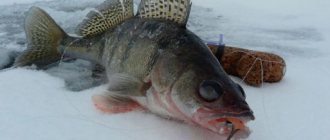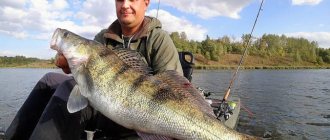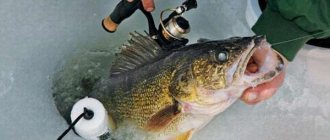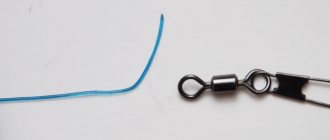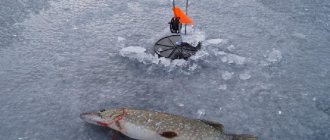Catching pike perch on a retractable leash has proven its worth in conditions where the predator does not show proper activity at obvious moments when its feeding activity decreases. Initially considered an effective method only for catching perch, the diverter successfully migrated to the rank of the pike perch direction of spinning fishing and took its rightful place among other equipment for catching fanged fish. Fishermen have developed a number of equipment modifications that meet the requirements of pike-perch fishing, thereby adding certain advantages to themselves, especially when the bite is depressed.
Today, spinners consider mastering some methods of installing a diverting leash on a pike perch to be a mandatory attribute in their technique, and it is precisely about mastering such techniques that the article will be presented to the reader. The information will focus on the important elements of the equipment configuration, methods of forming rigs and the most suitable baits for the equipment, and will also give an understanding of the technical side of wiring.
Advantages and disadvantages of this fishing method
A leash for pike perch perfectly solves a number of problems of passive biting of a predator, but it also has certain disadvantages that should be taken into account when planning the use of the method when catching fish. The positive aspects of this direction include:
- range of installations even in windy weather, in which fishing with other baits and equipment is difficult due to uncomfortable supply of equipment to the fishing zones.
- The equipment is quite susceptible to the slightest bites of a predator, which allows the spinner to find passive fish and, by experimenting with retrieves, increase his chances of a successful fishing outcome.
- the nature of the game of inert baits, attractively working from resistance to the forces of the current.
- Low-speed fishing techniques arouse the interest of low-active fish.
Among the disadvantages of the diversion we note:
- the difficulty of tying rigs, especially for beginner fishermen who will need practice in acquiring a stable skill in this type of work.
- high degree of hookiness of installation, entailing high consumption of baits and equipment.
- Due to their bulkiness, ties cause inconvenience when fishing in cramped conditions, especially when fishing from boats.
Separately about the wobbler
Such bait as a wobbler or suspender . The best are considered to be light, surface wobblers on a retractable leash for pike perch, which go deep a small amount.
But there are some nuances that can upset you when catching pike perch with a silicone wobbler - this is that when cast, it rotates around its axis and gets tangled .
However, with a preliminary check, this can be easily identified and corrected; to do this, you need to attach a small lead pellet . Thanks to this device, the equipment becomes more resistant to rotation.
Among the main baits for fishing on a retractable leash, there are various classic rubber jigs . The most effective are twisters , which need to be drunk with special attractants, which create a special smell that lures fish. Also, the fish holds such a bait in its mouth much longer, and the spinner has more time to hook .
Almost all experienced fishermen advise choosing bright, colored, even acidic baits.
Where to use the equipment
The best places for fishing for this type of rigs are rivers with moderate currents and clean, clear water, which have solid bottoms with small differences in its topography. Specifying the fishing locations, we note that these are:
- drops into the depths from spits and shallows.
- the edges of the main river bed and smooth exits from the pits.
- dead wood and snags in areas of reservoirs and areas adjacent to such places.
- smooth bottom plateaus with hard clay or sandy bases at depths of over four meters.
- fishing can be carried out near hydraulic structures, bridge supports, dams and dams.
- zones of reverse and divergent currents are promising.
- trajectories near steep banks with shading and at the radii of their turns.
- raising the bottom surrounded by depths.
- exits to the shallows from the main river channels, where the slowdown in current speed is clearly noticeable.
- At night, catching stretches with depths of 1 to 2 meters is promising, where the fanged predator goes out in the warm season to hunt for fry that accumulate in the dark.
Focusing on these features of the reservoir, the spinning angler has the right to count on ultimate success, because these are the zones that are the favorite place to stop and search for food for schools of pike perch.
Wires for catching pike perch
It’s easier to catch pike perch if you choose the right bait for the bait and the mood of the fish. On deep-water edges, fishing is carried out more often with the help of a jig, and on the adjacent shallows, mainly using wobblers. Let’s try to figure out further what fishing for which bait will be the best... Let’s look at the peculiarities of fishing for pike perch in river conditions with the usual difficulties - windbreaks along the shore, significant currents in deep, cluttered places. This kind of fishing for pike perch is of particular interest, because there are many good places for pike perch in these conditions, all that remains is to create suitable gear, and then use it correctly, including choosing the wiring.
Active pike perch in autumn
In autumn, pike perch are more often active, greedy for their victims, and take the bait with a gulp, so they are detected more reliably. In the fall, an actively moving bait is better suited for pike perch. To do this, it is recommended to use a slightly overloaded jig. Then you can make powerful, clear vertical throws on the step, as well as knocking on the bottom, which this predator undoubtedly likes when it fishes itself.
For fattening pike perch in the fall, high-speed retrieves are better suited, because now the fish are able to catch up and attack the bait, and fast movement causes more irritation, for example:
- 2 - 3 turns with the reel handle and a pause until the tip returns to its original position, the cycle is immediately repeated - again 2 - 3 quick turns...
In summer
Summer pike perch is usually moderately active, with the best bite at dawn, and not bad at night. During the day, it is more promising to look for it on deep-sea edges from 3 meters, and in the morning and evening on the adjacent shallows and dunes, where it rises and noisily chases the fry. In shallow water, wobblers are more interesting for shallow, stable depths and night fishing. But at depth - a classic jig with a load of 20 - 23 grams.
In summer, as opposed to autumn, it is more advisable to use complex wiring designed to provoke fish, which we will consider further
Posting for pike perch in summer
Several zander lines for summer fishing, for hinged mounting with an offset machine with a load of about 20 grams. The choice of slack after jerking is done by the reel.
- normal wiring - 2 - 3 turns of the coil and a pause;
- tossing the bait, then a short pull along the bottom up to 15 cm, a short pause and repeat...;
- a couple of tosses of the bait with a rod, then a short pause, again tosses, another pause - then stretching up to half a meter along the bottom with a toss - after a pause of 10 seconds, the cycle is repeated again;
- 2 jerks in a row, after a second 1 jerk, a smooth pull along the bottom with the coil, then a pause of several seconds and the process is repeated again.
Where is the largest pike perch caught?
The largest pike perch for a given area will typically be at depths of 5 - 8 meters, behind a single but significant cover. This is a trunk, a boulder, a hole, a support, perhaps a bunch of silted snags at the bottom... If such a place is found on a pike-perch river, then sooner or later it will yield a trophy fish. Particularly good are the places where there is also a shadow of the current from the hillocks or others in front. Then the pike perch does not strain behind its cover, i.e. will be there permanently.
Fishing in spring
In the spring, the current on the rivers is powerful, the water is muddy, so in the channel depression, on the deep-water edges - a typical place for summer and autumn fishing, it is unlikely that you will be able to meet and catch pike perch. Usually, even a load of 50 grams is carried away by the flow, skipping without control, so it is not even possible to create sane attractiveness with a jig on spring streams. But on the other hand, reverse currents at turns, snags on the banks, edges under the shore - places where you can usually fish with a load of up to 30 grams - help out.
Spring fishing for pike perch in the indicated quiet places of the river can be done without any special frills, just to achieve clarity in choppy water.
Wiring for pike perch in spring:
- two turns and a pause - without experimentation, then it will be more difficult to miss a bite with a taut cord and a controlled bait.
It is better to stand above the area being fished and cast against the current at an angle. Any suspicious incident with bait in high flows should be taken as a bite and hooked. Pike perch is not as active as during the autumn feeding season, so it can take it softly.
Regarding gear
- For jigging in the shallows, it is better to use relatively short but powerful bass series spinning rods, about 2.0 meters long. They detect better and more clearly control the bait at short distances.
- For regular fishing for pike perch at depth, for active fishing in the fall, choose a fast action 2.2 - 2.4 meters long and a reel size 4000.
- It makes no sense to use a thin cord, since shell rock found everywhere, including on flooded trunks, around which pike perch are found, will not give life. 20lb or more is the recommended cord to reduce problems.
- An important detail is the leash in the pike perch rig. Many fishermen assume that there will be pike, and therefore install pike leashes, which slow down the entire tackle. Regarding this, there are authoritative opinions that it is better to lose the bait occasionally from a pike attack than to miss bites from pike perch on rough tackle. Many experienced fishermen are guided by this and do not use any leashes not designed for pike perch.
Successful fishing for pike perch will not be possible without a set of modern jig baits, preferably from different manufacturers. The chassis are narrow-bodied and of medium length...
Wiring direction
A typical mistake is possible - constant repetition of movements in one direction relative to the stream of water, hence some monotony of the game and speed of movement, and therefore the sound of the bait under water. As a result, many reserves built into the gear are not used. You should change the direction of casting - across the current, at an angle, against the current. It is not uncommon for demolition wiring to become catchy. Somehow you need to achieve better animation of the bait, adapting to the strength and direction of specific jets. It is important to take into account that the speed of movement relative to the water, and therefore the noise of the wiring, and possibly the rise of turbidity, will be different for new directions, and the pike perch will definitely like which of the options.
Tackle used and selection of elements
Tackle for pike perch with the installation of a retractable leash in its configuration does not cause any particular difficulties, since it consists of ordinary spinning elements used in many areas of hunting for freshwater predatory fish. To ensure the accuracy of control over the movement of baits and the sensitivity of the gear as a result of the experience gained through practice in this type of spinning fishing, the fishermen formulated the main parameters of the performance characteristics of the components of the equipment, and also adopted forms and materials of the accessories of the equipment set that are effective for catching pike perch. The continuation of the article will give direction in assembling the most rational and convenient fishing tool for using the technique of posting with spaced equipment assembled according to the principle of a retractable leash.
Rod
The basis on which equipment for fanged fishing is assembled is a spinning rod with a fast or semi-fast action, 2.5 - 3 meters long. For casting from a boat, the lower length level is suitable. Fishing from the shore is carried out with a longer tool. The spinning rod material is best made from elastic composite and lightweight materials. The dynamic nature of fishing with such a rod will not greatly tire the angler’s hand when casting lures quite frequently.
The test parameter of a spinning rod for using a diverting leash has a fairly wide range of values, and this feature is associated not only with the weight of the equipment, but also with the needs of conducting retrieves in strong currents and great depths. A universal spinning rod option is considered to be a form with test weights from 10 to 35 grams. A specific tool for fishing at depths with strong traction must have an upper limit of the range of at least 50 grams.
Coil
The selected rod and reel must be in harmony and balanced in their masses. An inertia-free power and traction mechanism with a voluminous spool, which must accommodate a volume along the cord of at least 150 meters, is the most suitable option, providing comfortable and reliable fishing conditions. Undoubtedly, the device should have an adjustable friction brake, which allows it to resist breakages of equipment when hooking bait and playing fish. All of the above performance characteristics and nuances are selected in a mechanism with dimensions of 3000–4000 units. If a spinning player has sufficient experience in using a tool equipped with multiplier reels, it is possible to use this type of device, which provides greater tactile sensitivity of the gear, which is especially important when night fishing.
Leashes
Installation of a diverter leash for catching pike perch is carried out on a braided main cord, which allows you to more scrupulously and clearly control the movement of the bait and feel the moment of the bite. The diverter leash itself is made of monofilament. Its reliability, and therefore the breaking load, should be an order of magnitude lower than the breaking load of the main cord. This moment allows you to lose only the bait when hooking, without overloading the form and without losing the useful length of the braided cord.
Depending on the size of the trophy expected in the catch, monofilament rarely exceeds 0.2 mm in diameter. But it is worth paying attention to one important nuance of fishing, which presupposes the presence of pike in the hunting zone that can cut monofilament leashes, thus constantly violating the integrity of the equipment. For these conditions, the installation includes metal or Kevlar leashes that complement the monofilament element of the equipment, thereby ensuring safety in case of lost baits and guaranteeing a pleasant bycatch.
Important! When choosing the length of the leash, they are guided by the activity of the predator. If activity is low, long leashes reaching one meter work more effectively. With a high degree of fanged activity, the length is reduced to 30 cm.
Sinker
For a retractable leash, the most rational forms of sinkers are considered to be pear-shaped types of products and options that resemble an olive in appearance. The load must necessarily have a fastening eye in its design, and ideally this element of the component equipment should be in combination with a swivel. The masses of the load are taken based on the fishing conditions and, in particular, the strength of the current. In small currents and depths of up to three meters, a load not exceeding 20 grams is quite suitable. For deep-sea waters with strong traction, weights of sinkers weighing up to 50 grams will be required.
Hooks
Due to the high probability of the equipment getting snagged, it is convenient to use offset hooks for diverting. In addition, this particular type of hook is ideal for mounting all kinds of silicone baits, which are most often used in this type of fishing. The size of the accessory is selected based on the size of the silicone being attached.
Important! In pike perch fishing, the sharpness of the hook tip used in the tackle plays an important role. Since the pike perch has a bony mouth and, due to this physiological feature, a hard mouth, it is the high degree of sharpness of the sting that makes it possible to qualitatively detect a trophy that has come out to attack the bait.
In addition, the hook must be durable, made of hard but elastic steel.
The best spinning equipment for zander
However, neither bait nor wiring will provide a good catch if you do not pay enough attention to the equipment. Pike perch is not a pike, which, being hungry, rushes at everything, and not the ubiquitous perch. In addition, it lives in places full of stones and snags, and attacks prey exclusively from ambush. Getting it out of there is problematic because of the danger of breaking the tackle.
Catching pike perch on a retractable leash will save you from such problems. This kind of equipment is also called Moscow. Why this is so is unknown, but they say that it was invented in the capital. How is it better than the classic spinning montage?
Catching pike perch on a retractable leash has the following advantages:
- more natural bait play;
- increased sensitivity of gear;
- a load moving along the bottom and tapping additionally attracts a predator;
- low probability of direct hooks.
How to properly make a diverting leash for pike perch
Having collected the elements of the tackle, it is worth moving on to knitting the installation itself, which can be done using several different compositions of accessories and knitting methods. But, despite all these differences, the general principle of the installation remains unchanged and consists in attaching the leash to the main cord at a certain distance from its end, at which the load is attached. The weight stretches along the bottom, holding the equipment, and the leash with the bait, through the efforts of winding the cord with a reel and influencing the installation of the current, creates an attractive game. We will look at some of the popular assembly modifications in more detail.
With sliding load leash
This is one of the most sensitive installation methods. It consists of a device for sliding a piece of fishing line on a swivel along the main cord, with a sinker suspended at its end. A bait with a working piece of fishing line, a leash of the required length, is attached directly to the carabiner at the end of the main thread. The leash is attached to the carabiner through a swivel. This type of installation is especially convenient for long-distance casting.
Blind equipment
The assembly principle consists of a blind fastening of the load, which is tied directly to the end of the main fishing line. On the base itself, a non-tightening loop is made, the distance of which from the load depends on the fishing conditions, which is associated with the location of the fish in a certain water horizon and the strength of the current, which affects the movement of the silicone bait. A working leash is attached to the eyelet formed by forming a loop on the cord using a loop-to-loop method, thus eliminating the use of fastening elements and thereby thinning the tackle. The disadvantage of the scheme is the break of the main cord as a result of a dead hook of the load. Therefore, with this installation option, it is recommended to fish bottom areas that are clean and free of snags and other artificial obstacles.
Triple swivel rig
The triple swivel is effective when there is an active predator. Its sensitivity is lower, but the assembly of this circuit itself is considered one of the fastest. At the end of the main fishing line, a triple swivel is knitted, onto the mounting ears of which a piece of fishing line with a load and the leash itself are knitted. The design is convenient for assembly and fishing from a boat. It is subject to the least possibility of tangling and does not require special tying skills, and also eliminates a number of connections that must be made in fishing conditions, wasting precious time for fishing.
Snap on clasp
This scheme is based on a fastener at the end of the main cord, onto which leashes with a weight and a hook are mounted. The option is convenient due to the quick change of pre-prepared elements and the ability to combine different types of loads, leash lengths and baits. But the wiring of the outlet formed in this way is not particularly sensitive, and if castings are not carried out technically correctly, this type of installation is prone to frequent tangling.
Installation of a branch leash
The design is quite simple, so even a person who is not very knowledgeable about how to install such equipment can figure it out. The diverter leash for pike perch consists of the following elements:
- main line (preferably braided) 0.15-0.25 millimeters thick, about 100 meters long;
- the retractable leash itself is made of monofilament with a maximum cross-section of 0.2 millimeters, about 100 centimeters long;
- lead weight, preferably round in shape, weighing 5-30 grams;
- tee swivel;
- 2 carabiners.
To begin with, you need to cut a piece about 30 centimeters long from the main fishing line. Attach a load to one end through a carabiner, and tie the other to one of the branches of the tee swivel. Attach the main fishing line to the opposite branch of the tee so that you get a regular straight tackle with a weight at the end and a free side eye of the swivel. Retractable leashes for catching pike perch will be tied to it or fixed with a carabiner. They can be prepared in advance, in various lengths, with hooks or jig heads, as well as with a variety of ready-made baits.
Some anglers who hunt for predators recommend using fluorocarbon leashes for catching walleye. This predator, unlike pike, does not have the habit of snacking on them, but extra precaution will not hurt.
Lures for catching pike perch on a retractable leash
In theory, this type of installation is suitable for a wide range of baits, including not only silicone baits, but also wobblers, spinners, and bait of animal origin in the form of a dead fish or a crawler and a bunch of worm. But the practice of pike-perch fishing shows that silicone baits bring the greatest number of pike-perch bites, which determines the greatest use of this particular type of bait. Vibrotails and twisters with elongated body shapes and inert action are suitable for fishing. Often, pike perch are tempted to pick up a silicone worm. The color schemes of the silicones are not particularly important and have little effect on the number of bites.
Important! To a greater extent, the result is improved by the use of ribbed and edible rubber, which has a much stronger effect on the aggression of pike perch, affecting its sense of smell and accompanying the wiring with sound effects.
The use of wobblers and spinners is irrational due to frequent hooks and loss of equipment, which, of course, does not have a positive effect on the material support of fishing.
Catching pike perch on a retractable leash
The technique of wiring the equipment is not unusual in execution and is quite accessible to a fisherman who has the slightest knowledge of how to work with a spinning rod. We will focus on the main methods in the continuation of our material.
Dash-and-dotted wiring is based on dragging baits along the bottom of the fished reservoir with alternating pauses. The angler pulls the equipment through the tip of the rod, tracking bites at stops, at the moment of a pause.
Drawing - the principle is based on maintaining uniform pulling after the load reaches the bottom. The fisherman winds the line without stopping at a slow speed, constantly monitoring the operation of the quiver tip of the tackle and, at the slightest failure, making a hook.
Pulling is a method whose technique involves casting the rig as far as possible and completely lowering it to the bottom of the reservoir. After reaching the bottom, the fisherman, using a reel, without lifting the bait from the ground, pulls the equipment along a promising trajectory, raising a muddy path with a load in contact with the bottom and thus attracting fish into the fishing zone. At some moments, you can stop the movement of the silicone, resuming subsequent wiring with a small detonation of the bait.
All these fishing techniques require scrupulous control over the movement of the rod tip, in the event of unnatural vibrations of which a sharp pull is made, ensuring reliable hooking of the fish. The peculiarities of fishing are to force the winding of the cord with a reel when there is a feeling of heaviness on the hook in order to avoid the trophy from moving into snagged areas where blind hooks are possible. In clean waters, there are no difficulties with landing pike perch even of large sizes. The fish does not show any special fighting qualities and, if hooked reliably, in most cases becomes a guaranteed trophy for the spinning angler.
Spinning wires
Catching pike perch on a retractable leash is used mainly for fishing in the cold season: early spring and late autumn. During this period, the pike perch is either too active or practically does not crawl out of its abode. To make fishing successful, you can use the following wiring:
- uniform;
- “stop and go” wiring;
- jig or step;
- twitching.
When the predator is most active, uniform wiring is ideal. To do this, you need to cast and wait until the load drops to the bottom, which will be signaled by the tip of the spinning rod. After this, you can begin to reel in the fishing line with even movements without pauses. It is important to feel the movement of the load along the bottom. With a faster movement of the spool, the bait will be in the water column.
“Stop and go” fishing also involves fishing in the bottom space, but unlike regular fishing, pauses are made here lasting two to three seconds. This option can be used when pike perch are not very active.
A stepped retrieve or jig is considered the most effective for catching pike perch. They use it regardless of the time of year and the activity of the predator. The essence of stepped retrieving is that the bait is allowed to sink to the bottom, after which four or five sharp turns of the reel are made, during which the bait comes off the surface, jumps up and falls again. Between these pull-ups there is a pause, the length of which is determined by the fisherman himself, but is no more than ten seconds.
When twitching, the tackle is jerked not by rotating the spool, but by a sharp movement of the spinning rod to the side or a low-amplitude twitching of its tip. Such vibrations irritate and attract pike perch. Most often, such wiring is used to fish an area and search for predator sites. Have a nice catch!
